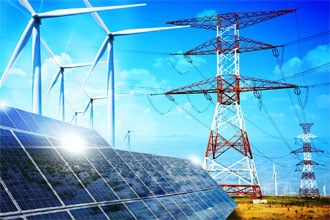
High Voltage Ride Through
Introduction to High Voltage Ride Through (HVRT)
![]() High Voltage Ride Through, or HVRT for short, is an important feature in todays modern alternative energy generating systems. As power systems worldwide increasingly rely on renewable energy sources such as wind and solar, it is important that they remain connected and fully operational during voltage transient conditions, or an unexpected surge in their DC link voltage which can occur due to various voltage disturbances or faults within the utility grid.
High Voltage Ride Through, or HVRT for short, is an important feature in todays modern alternative energy generating systems. As power systems worldwide increasingly rely on renewable energy sources such as wind and solar, it is important that they remain connected and fully operational during voltage transient conditions, or an unexpected surge in their DC link voltage which can occur due to various voltage disturbances or faults within the utility grid.
When a utility grid experiences some form of a fault or disturbance, their voltage levels can temporarily fall or rise significantly above their normal operating values. Without HVRT capabilities, these transient voltage events can cause disconnection of wind or solar generations from the connected grid causing even further instability and potential outages.

Importance of HVRT in Renewable Energy Systems
The ability of a renewable energy system to withstand voltage disturbances has emerged as a critical factor in ensuring the reliability and efficiency of solar power. With the proliferation of solar PV installations worldwide, the importance of HVRT cannot be overstated, as it ensures a continuous power supply.
What does HVRT Stand For
High voltage ride through, or HVRT is a crucial feature of wind turbine control and power converter systems. It refers to the ability of grid-connected energy systems to withstand high voltage levels without disconnecting from the grid by allowing wind turbines or large solar arrays to “ride through” (hence the name) any voltage transient event. This capability is essential to prevent islanding scenarios maintaining their connection to the utility grid, preventing cascading failures and improving overall grid stability for a more reliable and sustainable energy future.
HVRT in Solar Photovoltaic Systems
An grid-tied solar power inverter is the heart of a solar photovoltaic (PV) system, since it converts the free solar generated DC power into AC power in synchronisation with the utility grid. But the inverter does much more having additional functions such as maximum power point tracking (MPPT), grid monitoring, and anti-islanding protection as well as DC to AC conversion to safely feed high quality AC power into the connected grid.
During a ride-through event, the inverter continues to operate under a defined duration of low or high grid voltage. A voltage ride-through is the capability of the inverter to maintain output current and remain online when grid voltage is temporarily outside the nominal dead band.
When the utility grid voltage drops below a preset low voltage threshold while the inverter remains online, the event is called a low (zero) or low voltage ride through (LVRT). Likewise, when utility grid voltage goes above a preset high voltage threshold while the inverter remains online, the event is called a high voltage ride through (HVRT)
The implementation of high voltage ride through (HVRT), as well as low voltage ride through (LVRT), and anti-islanding features in solar PV systems involves several key strategies:
- The Rapid Reduction of Generation: This limits the magnitude and duration of high voltage excursions, thereby protecting the system components.
- Quick Reconnection: Following short-duration high voltage events, systems must be able to reconnect to the grid swiftly to minimize disruptions.
- Enhanced System Stability: By avoiding mandatory time delays and controlling ramp rates associated with reconnection, the overall stability of the grid voltage is significantly improved.
Moreover, the operating regions for HVRT are defined by specific parameters such as voltage and time or frequency and time. Each region has tailored responses designed to address different grid issues like over-voltage or under-voltage events.
The strategies include adjusting the DC-link voltage reference based on real-time grid voltage and load current data, and controlling the inductive reactive current of grid-connected inverters (GCI). This adaptive approach ensures that the PV system remains controllable and stable under varying grid conditions.
Impact of High Voltage Ride Through on Wind Energy
As well as and doubly fed induction generators (DFIG), modern wind turbines use advanced inverter and converter technologies which can handle any high voltage conditions using software algorithms that detect and respond to any unwanted high voltage event. These algorithms can adjust and modulate the wind turbines output and protect it from damage against over-voltage.
The building of large wind farms both onshore and off-shore has increasing rapidly over recent years. These wind farms turbines are connected into the main electric grid which could cause grid stability issues. Thus during low-voltage ride-through (LVRT) and high-voltage ride-through (HVRT) events, wind turbines are required to support the utility grid to regain stability.
Then high voltage ride through protection is crucial for wind energy turbines as it ensures grid stability during voltage surges by allowing turbines to remain operational rather than disconnecting. Also, repeated exposure to high voltage conditions can accelerate the wear and tear on turbine components, especially their power electronics, transformers, and generators potentially leading to higher maintenance costs and reduced lifespan.
Advantages of HVRT in Renewable Energy Systems
It is clear that high voltage ride through (HVRT) capability in renewable energy systems offers significant advantages, particularly in terms of grid stability and economic and operational benefits by allowing energy systems to remain connected during high voltage events.
This connection is crucial as it enables the systems to provide reactive power support, which is essential in maintaining voltage levels and preventing cascading instability issues across the grid. By contributing to voltage regulation, HVRT-equipped wind turbine and solar powered PV systems play a pivotal role in stabilising the grid during fluctuations caused by sudden changes in load or generation capacity.
From an economic perspective, the ability of solar PV systems to continue operating during high voltage situations allows for uninterrupted electricity generation. This capability not only ensures a consistent power supply but also enhances the financial performance of solar installations by maximising uptime and energy production.
Operationally, HVRT reduces the risk of disconnections and the potential penalties associated with such events. The ongoing operation during grid disturbances minimises downtime and associated costs, thereby improving the overall efficiency and reliability of wind and solar PV systems contributing to a more reliable and sustainable energy future.
The deployment of high voltage ride through in renewable and sustainable energy systems faces several challenges. One of the primary issues is the limited voltage withstand capability of inverters, converters and other power electronic components, which can be exceeded during high voltage events, leading to system tripping or shutdown. Additionally, these systems often struggle with reactive power handling during these events, which is essential for grid voltage regulation but exceeds the capabilities of many inverters.
The complexity of control systems required to manage voltage, current, and reactive power during high voltage events adds another layer of difficulty, increasing the risk of unreliable operation. Furthermore, variations in grid impedance can significantly affect the voltage profile experienced by a solar system during high voltage events, posing a challenge for designing robust HVRT solutions.
To learn more about high voltage run through, and the deployment of robust HVRT-equipped inverters and renewable installations. Then Visit Amazon to see a range of related solar photovoltaic (PV) inverters and books about the fundamentals of high voltage ride through, its implementation in solar photovoltaic systems, and the consequent advantages it brings to the stability and efficiency of the electrical grid.





![Pure Sine Wave 2500 Watt Car Power Inverter 2500w Converter DC 12V to 110V-120V AC with LCD Display 2 AC Outlets 2x2.4A USB Ports 1 AC Terminal Block Remote Control[3 Years Warranty] by VOLTWORKS](https://m.media-amazon.com/images/I/51hq3dtOzYS.jpg)





Please Speak up!
We hope this High Voltage Ride Through Tutorial was useful and informative for you. Are you ready to share your thoughts
and experience with us and many others. Your comments are always welcome, just post them in the section below.
P.S. Don't forget to like, rate, and share this Alternative Energy Tutorials post. Thank you for using our website.